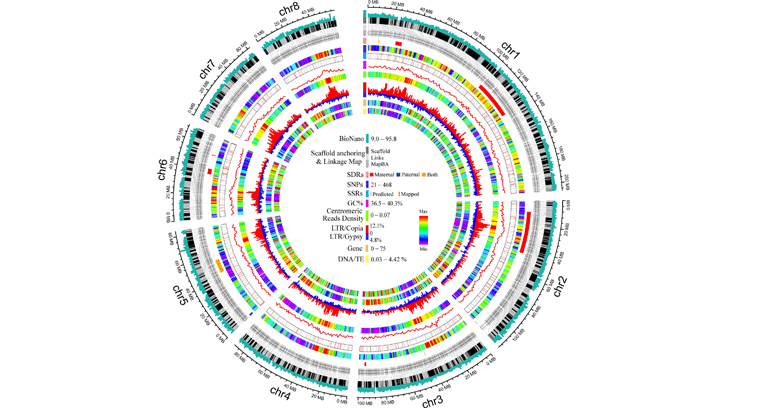博文
the plant journal:莲花基因组组装更新到染色体级别
||
Improving Nelumbo nuciferagenome assemblies using high-resolution genetic maps and BioNano genome mapping reveals ancient chromosome rearrangements
First author: Songtao Gui; Affiliations: Wuhan University (武汉大学): Wuhan, China
Corresponding author: Yi Ding (丁毅)
Genetic and physical maps are powerful tools to anchor fragmented draft genome assemblies generated from next‐generation sequencing. Currently, two draft assemblies of Nelumbo nucifera, the genomes of ‘China Antique’ and ‘Chinese Tai‐zi’, have been released. However, there is presently no information on how the sequences are assembled into chromosomes in N. nucifera. The lack of physical maps and inadequate (不充足的) resolution of available genetic maps hindered (阻碍) the assembly of N. nucifera chromosomes. Here, a linkage map of N. nucifera containing 2371 bin markers [217 577 single nucleotide polymorphisms (SNPs)] was constructed using restriction‐site associated DNA sequencing data of 181 F2 individuals and validated by adding 197 simple sequence repeat (SSR) markers. Additionally, a BioNano optical map covering 86.20% of the ‘Chinese Tai‐zi’ genome was constructed. The draft assembly of ‘Chinese Tai‐zi’ was improved based on the BioNano optical map, showing an increase of the scaffold N50 from 0.989 to 1.48 Mb. Using a combination of multiple maps, 97.9% of the scaffolds in the ‘Chinese Tai‐zi’ draft assembly and 97.6% of the scaffolds in the ‘China Antique’ draft assembly were anchored into pseudo‐chromosomes, and the centromere regions along the pseudo‐chromosomes were identified. An evolutionary scenario was proposed to reach the modern N. nucifera karyotype from the seven ancestral eudicot chromosomes. The present study provides the highest‐r esolution linkage map, the optical map and chromosome level genome assemblies for N. nucifera, which are valuable for the breeding and cultivation of N. nucifera and future studies of comparative and evolutionary genomics in angiosperms.
遗传和物理图谱是将二代测序组装形成的片段化基因组草图组装到染色体水平的有力工具。目前,莲花的两个品种“China Antique”和“Chinese Tai‐zi”已经释放了基因组草图。然而,目前并没有关于莲花基因组组装到染色体水平的报道。由于缺少物理图谱,而可用的遗传图谱分辨率不足等原因限制了莲花染色体水平基因组组装的构建。本文通过181个F2代群体的限制性位点相关DNA测序所获得的2371区间标记,包含217 577个SNP,进行了遗传图谱构建,并进一步利用197个简单重复序列SSR进行了验证。另外,作者还构建了BioNano光学图谱,覆盖了86.20%的“Chinese Tai‐zi”基因组。利用BioNano光学图谱提升了“Chinese Tai‐zi”基因组组装质量,其中scaffold N50长度从0.989 Mb增加到了1.48 Mb。利用多种图谱辅助构建,“Chinese Tai‐zi”基因组草图97.9%的scaffold和“China Antique”基因组草图97.6%的scaffold能够挂载到假染色体上,作者还鉴定了假染色体上的着丝粒区。作者提出了从双子叶古七倍体到如今莲花基因组核型的演化过程。本文提供了莲花的高精度遗传图谱、光学图谱和染色体级别的组装结果,这对于未来莲花育种、栽培具有重要价值,同时为未来关于被子植物的比较和演化基因组研究提供可利用数据资源。
通讯:丁毅 (http://www.bio.whu.edu.cn/index.php/View/1998)
研究方向:植物细胞分子遗传学;植物基因组与分子进化遗传学;植物基因组学与蛋白质组学。
doi: https://doi.org/10.1111/tpj.13894
Journal: the Plant Journal
First Published date: 15 April, 2018
(P.S. 欢迎关注微信公众号:微信号Plant_Frontiers)
https://blog.sciencenet.cn/blog-3158122-1109399.html
上一篇:Plant Biotechnol J:阿拉比卡咖啡基因组揭示咖啡因含量相关SNP
下一篇:New Phytologist:东亚植物物种多样性高的解释
全部作者的其他最新博文
- • Plant Physiology:CsMADS3促进柑果中的叶绿素降解和类胡萝卜素合成(华中农业大学)
- • Molecular Plant:LBD11-ROS反馈调节作用于拟南芥的维管形成层增殖和次生生长(浦项科技大学)
- • Science Advances:根结线虫通过调控植物的CLE3-CLV1模块,促进侵染进程(日本熊本大学)
- • Nature Communications:油菜素内酯参与植物营养生长期转变的分子机制解析(浙江农林大学)
- • Current Biology:光合作用产生的蔗糖驱动侧根“生物钟”(德国弗莱堡大学)
- • PNAS:花同源异型基因在叶中被抑制、花中被激活的分子机制(南卡罗来纳大学)

